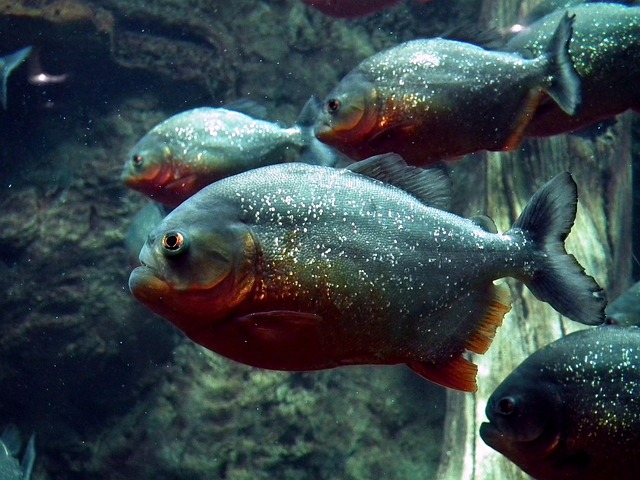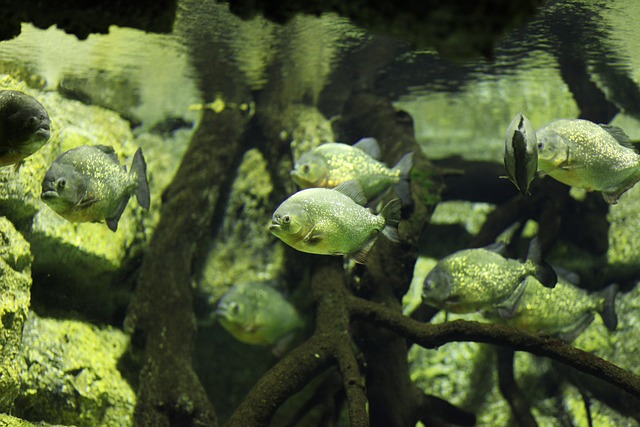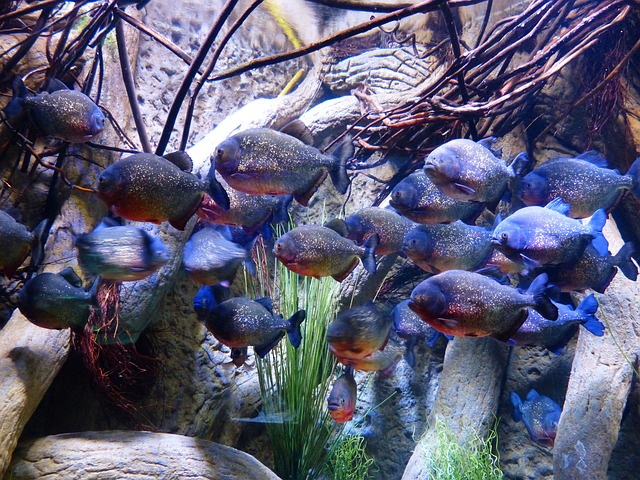Piranhas have long been portrayed as ferocious creatures with a voracious appetite for human flesh. These notorious fish have become the subject of countless myths and misconceptions, leading to a negative and often exaggerated reputation. However, the truth about piranhas is far from what we have been led to believe. In this article, we aim to debunk these myths and shed light on the fascinating nature of these creatures.
From their remarkable adaptations to their role in their ecosystem, piranhas have much more to offer than just their sharp teeth and aggressive behavior. By exploring the truth about piranhas, we can better understand and appreciate these unique aquatic creatures and their importance for conservation and management.
Table of Contents
The Truth About Piranhas
Piranhas, also known as “caribe” in Spanish, have long been feared and portrayed as vicious and bloodthirsty predators in popular culture. From movies to books and urban legends, these carnivorous fish have earned a reputation as killers with a voracious appetite for human flesh. However, as with many misunderstood creatures, there is more to piranhas than meets the eye. In this section, we will debunk common myths surrounding piranhas and shed light on their true nature.

One of the biggest misconceptions about piranhas is their supposed insatiable hunger for human flesh. While it is true that piranhas are predatory fish, they do not specifically seek out humans for food. In fact, their diet consists mostly of small fish, insects, and plants. They are opportunistic feeders, meaning they will eat whatever is available to them. This can include dead animals, fruits, and even other piranhas. They are not the ruthless killers they are often portrayed to be.
It is important to understand the truth about piranhas for their conservation and management. The fear and negative perceptions associated with these fish have led to their unjust persecution and decline in population. In reality, piranhas play a vital role in their ecosystems and deserve to be protected. By debunking myths and educating the public, we can promote a better understanding and appreciation for these fascinating creatures.
Another common misconception is that all piranhas are the same. In reality, there are more than 30 different species of piranhas, each with its own unique characteristics and adaptations. One of the most well-known species is the red-bellied piranha, known for its sharp teeth and aggressive nature. However, not all piranhas have the same sharp teeth, and not all of them are aggressive. Each species has evolved specific physical and behavioral adaptations that make them successful predators in their respective habitats.
For example, some piranhas have flat, grinding teeth for crushing nuts and seeds, while others have pointed teeth for tearing flesh. Some species have adapted to live in fast-flowing rivers, while others thrive in calm waters. These adaptations allow piranhas to utilize different food sources and habitats, making them resilient in the face of environmental changes.
Piranhas also play a vital role in their ecosystems by controlling populations of other species. As scavengers, they help clean up their habitats by consuming dead animals and preventing the spread of disease. They also help maintain balance in food webs by keeping the populations of their prey in check. Without piranhas, these ecosystems could suffer from overpopulation and imbalance.
In conclusion, the truth about piranhas is far from the myths and misconceptions that surround them. They are not mindless killers, but rather complex and adaptable creatures with an important role in their ecosystems. By understanding and respecting these fish, we can ensure their conservation and help dispel the negative stereotypes that have unfairly plagued them.
The Remarkable Adaptations of Piranhas
Piranhas have been portrayed as ruthless and bloodthirsty predators in popular culture and media. However, the truth is that these creatures have a remarkable set of adaptations that make them successful hunters and key players in their ecosystems. In this section, we will dive deeper into the unique characteristics and behaviors that enable piranhas to thrive in their natural habitats.
Physical Adaptations:
One of the most notable adaptations of piranhas is their razor-sharp teeth. These teeth are interlocking and serrated, allowing them to easily tear through the flesh of their prey. Their teeth are also continuously replaced, ensuring that they are always sharp and effective. Additionally, piranhas have a powerful jaw and strong muscles, which allow them to exert a force three times their own body weight. This enables them to crush hard shells and bones for their food.
Another physical adaptation of piranhas is their streamlined body shape. This allows them to move swiftly through the water, making it easier for them to catch prey or escape from predators. Their dorsal and pectoral fins are also positioned strategically, providing them with excellent control and agility. These adaptations make piranhas incredibly efficient hunters, able to quickly maneuver and strike at their prey with precision.
Behavioral Adaptations:
Aside from their physical adaptations, piranhas also have remarkable behavioral adaptations that contribute to their success as predators. One of the most intriguing behaviors of piranhas is their schooling behavior. They often gather in large groups, known as shoals, to hunt and defend their territory. This behavior provides them with strength in numbers and allows them to effectively take down larger prey. It also serves as a defense mechanism against predators.
Piranhas also have the ability to change their coloration to match their environment. This is known as cryptic coloration and helps them avoid detection from both prey and predators. They can also produce a silvery hue on their scales, which reflects light and makes them less visible to their prey.
Unique Species:
There are over 25 species of piranhas, each with its own unique adaptations. For example, the red-bellied piranha has a distinctive red hue on its belly, giving it its name. It also has a particularly aggressive nature, often attacking and eating other piranhas. The black piranha, on the other hand, has the strongest bite force of all piranha species, capable of crushing even the hardest shells and bones.
Importance for Survival:
These adaptations are crucial for the survival of piranhas in their natural habitats. They allow them to compete for food, defend themselves against predators, and maintain a balanced ecosystem. Without these adaptations, piranhas would not be as successful in their environment and could face extinction.
In conclusion, piranhas are not just mindless killing machines, as they are often portrayed. They have a remarkable set of adaptations that make them fascinating creatures and vital components of their ecosystems. Understanding and appreciating these adaptations is crucial for their conservation and management.
The Role of Piranhas in Their Ecosystem
Piranhas have long been feared and misunderstood as vicious predators, but their role in their native ecosystems is much more complex and vital. These scavenging fish play a crucial role in maintaining the delicate balance of their habitats and have a significant impact on the populations of other species. In this section, we will explore the ecological importance of piranhas and their role in maintaining the health of their ecosystems.

One of the main functions of piranhas in their ecosystems is their role as scavengers. While they are known for their sharp teeth and aggressive nature, piranhas primarily feed on dead or dying animals, making them important cleaners of their environment. They help to prevent the spread of disease by consuming carcasses that could otherwise contaminate the water and affect other species. This scavenging behavior also plays a critical role in nutrient cycling, as piranhas break down and recycle essential nutrients in their ecosystem.
Furthermore, piranhas play a significant role in controlling the populations of other species in their habitats. As opportunistic feeders, piranhas will prey on smaller fish, insects, and even larger animals like birds and mammals when given the opportunity. This helps to keep populations of these species in check, preventing overpopulation that can have detrimental effects on the ecosystem. In turn, this maintains a healthy balance in the food web and ensures the survival of various species.
In addition to their important role as scavengers and population controllers, piranhas also have a direct impact on the physical environment of their habitats. Their constant foraging and movement help to aerate and mix the water, which is essential for the survival of other aquatic species. Piranhas also contribute to the natural erosion of riverbanks and help to maintain the structure of their habitat. These behaviors may seem destructive, but they are vital for the health and stability of their ecosystem.
The decline or extinction of piranhas could have severe consequences for their ecosystems. Without their scavenging and population control, the build-up of decaying matter could lead to an increase in disease and contamination in the water. The imbalance in the food web could also result in overpopulation of certain species, leading to the depletion of resources and potential ecosystem collapse. Therefore, it is crucial to protect piranhas and their habitats to maintain a healthy ecosystem.
In conclusion, piranhas are not mindless killing machines, but rather essential creatures that play a critical role in their ecosystems. As scavengers, population controllers, and ecosystem engineers, they contribute to the health and balance of their habitats. The continued survival of piranhas is vital for the preservation of their ecosystems and the countless species that depend on them. We must continue to educate and raise awareness about the ecological importance of piranhas to ensure their conservation and management.
Human-Piranha Interactions
Piranhas have long been portrayed as vicious and dangerous creatures, instilling fear and fascination among humans. This has led to various myths and misconceptions surrounding these freshwater fish, often leading to negative interactions between humans and piranhas. However, it is important to understand the truth about these creatures and their role in their ecosystem to promote coexistence and conservation efforts.
Human-piranha interactions have a long history, with piranhas being an integral part of the culture and traditions of many South American communities. In some regions, piranhas are considered a delicacy and are an important source of food for local communities. However, outside of these areas, piranhas are often viewed as bloodthirsty and dangerous predators, leading to fear and negative perceptions.
One of the main reasons for this fear is the portrayal of piranhas in popular media, where they are depicted as ruthless killers. While it is true that piranhas have sharp teeth and are opportunistic feeders, their main diet consists of fish, insects, and other aquatic animals. In fact, studies have shown that piranhas rarely attack humans and are more likely to scavenge on already dead animals.
Piranhas play a crucial role in their native ecosystems as scavengers and predators, helping to maintain a balance in food webs. They also play a role in controlling the populations of other species, preventing overpopulation and potential ecological imbalances. This highlights the important role piranhas play in their environment and the potential consequences of their decline or extinction.
Unfortunately, human activities such as habitat destruction and overfishing have put piranha populations at risk. This has led to conflicts between humans and piranhas, where fishermen and farmers view them as competitors for resources and may resort to killing them. However, it is important to note that these actions not only harm piranha populations but also disrupt the delicate balance of their ecosystems.
To promote sustainable coexistence, efforts have been made to educate and raise awareness about the true nature of piranhas. Eco-tourism is also a growing trend, providing opportunities for people to safely observe and learn about piranhas in their natural habitat. Fishing practices have also been improved to minimize the negative impact on piranha populations, allowing for a more sustainable use of resources.
In addition to these efforts, there is a need for more research and conservation measures to protect piranhas. This includes studying their behavior and ecological roles, as well as implementing measures to protect their habitats and regulate fishing practices. It is important for humans to understand and respect the vital role piranhas play in their ecosystem and work towards their conservation.
In conclusion, human-piranha interactions have been shaped by fear, myths, and misconceptions. However, by understanding the truth about these creatures and promoting sustainable coexistence, we can protect and appreciate the remarkable nature of piranhas. It is crucial to prioritize their conservation to ensure the preservation of these unique and important species for generations to come.

The Threats to Piranhas
Despite their reputation as fierce predators, piranhas face a number of threats in their natural habitats. These threats not only put the survival of piranha populations at risk, but they also have wider implications for the health of entire ecosystems. In this section, we will explore the various threats facing piranhas and the efforts being made to protect these fascinating creatures.
- Habitat Destruction:
One of the main threats facing piranhas is the destruction of their habitats. As human populations continue to grow, the demand for land and resources has led to the destruction of the Amazon rainforest, where many piranha species are found. Deforestation not only reduces the available habitat for piranhas, but it also affects the water quality and can lead to changes in the food web, ultimately impacting piranha populations.
- Overfishing:
Piranhas are a popular food fish in many parts of South America, and their numbers have been declining due to overfishing. In some areas, piranhas are also targeted for their teeth, which are used in traditional medicine and as souvenirs. Overfishing can disrupt the delicate balance of ecosystems, leading to the decline of piranhas and other species that rely on them for food.
- Pollution:
Pollution from agricultural and industrial activities can also have a significant impact on piranha populations. Pesticides and other chemicals can contaminate the water and affect the health of piranhas, making them more susceptible to disease and reducing their ability to reproduce. Pollution can also affect the prey species of piranhas, leading to a decline in their food supply.
- Invasive Species:
The introduction of non-native species into piranha habitats can also pose a threat. In some areas, piranhas have been outcompeted by other species such as tilapia, which can affect their food supply and lead to a decline in their populations. In addition, some non-native species may carry diseases or parasites that can harm piranhas.
Efforts to Protect Piranhas:
In recent years, there have been increasing efforts to protect piranhas and their habitats. One such effort is the creation of protected areas in the Amazon, where fishing and other activities that may harm piranhas are restricted. These protected areas not only provide a safe haven for piranhas but also help to preserve the diverse ecosystems in which they live.
In addition to protected areas, education and awareness campaigns have been launched to help dispel the myths surrounding piranhas and promote their conservation. By educating the public about the important role piranhas play in their ecosystems, we can work towards changing negative perceptions and fostering a greater appreciation for these creatures.
More research is also needed to better understand the threats facing piranhas and to develop effective conservation strategies. This includes studying their behavior, population dynamics, and the impacts of human activities on their habitats.
Conclusion:
Piranhas may have a fierce reputation, but they are also important members of their ecosystems. The threats facing piranhas not only put their survival at risk but also have wider implications for the health of the Amazon rainforest and the species that call it home. It is crucial that we continue to work towards protecting these remarkable creatures and their habitats for future generations to enjoy. Through sustainable practices and ongoing conservation efforts, we can ensure that piranhas continue to thrive in their natural habitats.
